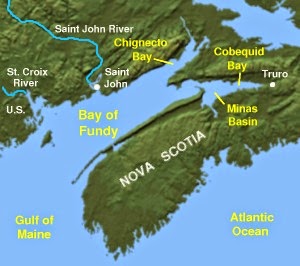This week, we waaaay passed the 20,000 views mark—thanks to all of you! The top 5 favorite episodes of all time (and they're good ones!):
Brooklyn Brine & The Science of Making Pickles (watch it here)
Mushrooms in the City (watch it here)
Elevator B and the Bees of Buffalo (watch it here)
Hot Air Balloon Over Poughkeepsie (watch it here)
The French Fry Boat (watch it here)
We couldn't have done it without you! As the new school year starts, we hope you'll join us for another great season. And as always, teachers, you can check out every episode with your class on our dedicated channel on SchoolTube.
xxx,
Lela
Friday, August 29, 2014
Wednesday, August 27, 2014
Bay of Fundy Tides—Coming Soon!!
Here's another photo to tide (har har) you over, until we can get the next episode up and running! Meanwhile, write in and let us know what science you ran into on your summer vacation.
Friday, August 15, 2014
A New Episode from the Bay of Fundy is Coming!
Here's a little photo taste of what's in store!! Looks like a view of the future, seen from 1969, doesn't it? Knobs, dials, and not a computer in sight. What could it be? (Hint: TIDES!!)
Saturday, August 9, 2014
High Tide/Low Tide in the Bay of Fundy
This is the Bay of Fundy in eastern Canada. At its highest, it is filled with something like 16 billion tons of water. Sound like a lot? It is! In fact, it is equivalent to the flow of all the water in all the freshwater rivers in the world!
The Bay of Fundy is home to our planet's most extreme tides. At high tide (see above), it reaches up to about 55 feet at its innermost point in the Minas Basin (see the map below).
At low tide—which happens twice every day—the water laps back and back toward the Gulf of Maine. As it goes, it leaves snails,
fishing boats,
and even islands stranded in the thick red limestone muck that lies at its bottom.
Why are the tides here so high? It's because of something called tidal resonance. Have a look at the map again. Imagine you are tilting it so the water flows out of the Bay, toward the Gulf. The time it takes for that giant wave of water you'd create to flow all the way out, then all the way back, coincides perfectly with the tides of the Atlantic Ocean. The Atlantic's high tide gives the water in the Bay a big push as it surges back in. Then the water gets squeezed up and up as it enters the narrow Minas Basin and approaches Burntcoat Head, where the very highest tides have been recorded. That's Burncoat Head beach in the photo above—two whole hours before dead low tide!
Stay tuned for a full episode about an amazing feature of the Bay of Fundy's tides, coming soon!
Subscribe to:
Posts (Atom)







